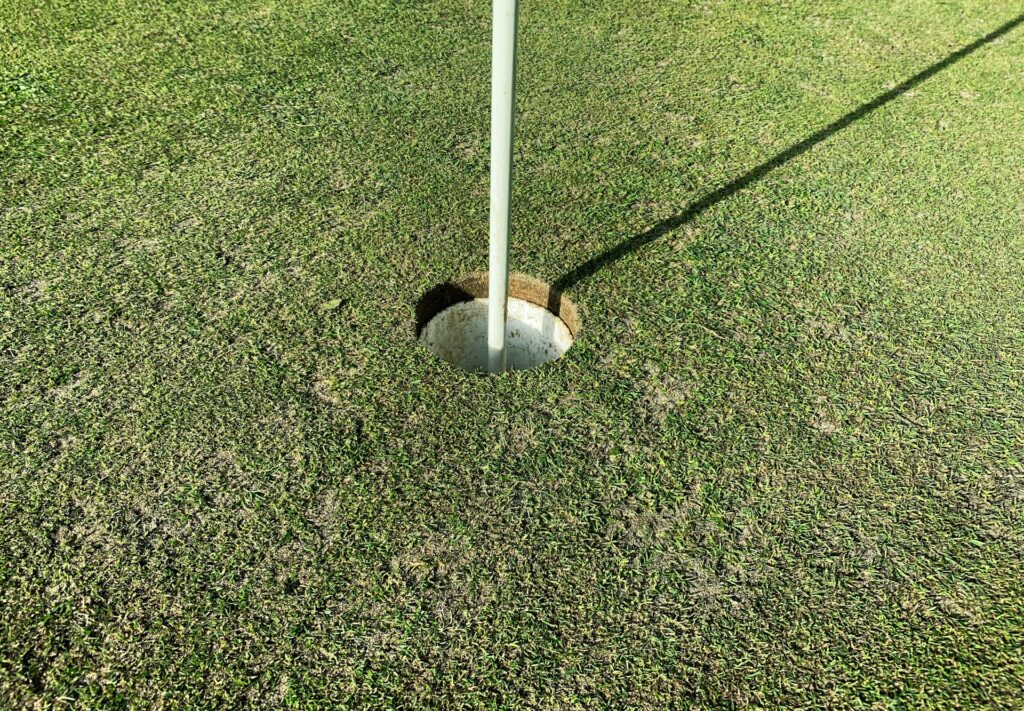
For many amateur golfers, breaking 80 is a significant milestone that represents a level of proficiency and consistency in the game. Shooting a score under 80 strokes for a complete 18-hole round is a challenging yet achievable goal that separates casual players from those with a more advanced skillset.
Breaking 80 requires a combination of physical abilities, such as accurate ball-striking, distance control, and a reliable short game, as well as mental fortitude and sound course management strategies. It’s a testament to a player’s ability to minimize costly mistakes, recover from occasional mishits, and capitalize on scoring opportunities while navigating the complexities of various course layouts and conditions.
While the journey to breaking 80 can be a long and challenging one, it is a pursuit that provides a sense of accomplishment and opens doors to new opportunities in the golfing world. It serves as a stepping stone towards achieving even lower scores and setting new goals, fueling the desire for continuous improvement and excellence on the course.
In this comprehensive guide, we’ll explore the key factors that contribute to breaking 80, from technical skills like driving accuracy, iron play, and short game proficiency, to mental strategies for maintaining focus, emotional control, and a positive mindset. We’ll also delve into effective practice routines, course management tactics, and strategies to stay motivated throughout the journey.
What is Breaking 80 in Golf?
Breaking 80 in golf refers to shooting a score under 80 strokes for a complete round of 18 holes. This milestone is widely considered a significant achievement for amateur golfers and a benchmark for solid play. It represents a level of skill and consistency that separates casual players from those who have developed a comprehensive understanding of the game.
To put it into perspective, a golf course with a par of 72 (a typical par for many courses) would require a player to shoot 8 over par or better to break 80. This means that a golfer must display a combination of accurate tee shots, precise iron play, a reliable short game, and sound course management strategies to keep their score under control.
While breaking 80 may seem like a daunting task for beginners, it is a realistic and attainable goal for dedicated golfers who are willing to invest time and effort into improving their skills. It requires a blend of physical abilities, such as consistent ball-striking and distance control, as well as mental fortitude to maintain focus and composure throughout the round.
Achieving a score in the 70s is a testament to a player’s ability to minimize costly mistakes, recover from occasional mishits, and capitalize on scoring opportunities. It signifies a level of proficiency that allows golfers to navigate the complexities of various course layouts and conditions while consistently executing the fundamental shots required in the game.

Why is Breaking 80 a Significant Milestone?
Breaking 80 is a significant milestone in golf because it serves as a benchmark that separates casual players from those with a more advanced skill set. Achieving this score demonstrates that a golfer has developed a well-rounded game and has reached a level of consistency that is not easily attained by the average recreational player.
For many amateur golfers, breaking 80 represents a psychological barrier that can be challenging to overcome. It requires a level of focus, discipline, and mental toughness that is often tested throughout the round. Conquering this barrier is a source of immense satisfaction and a testament to the hard work and dedication put into improving one’s game.
Additionally, breaking 80 is a notable achievement because it unlocks new opportunities and experiences in the golfing world. Many tournaments and competitions have specific handicap requirements, and breaking 80 can open doors to participate in these events, allowing players to test their skills against others of similar ability levels.
Moreover, breaking 80 is significant because it serves as a stepping stone towards achieving even lower scores and setting new goals. Once a golfer has tasted success in consistently shooting in the 70s, they may be motivated to push themselves further and strive for even greater accomplishments, such as breaking 70 or shooting par or better.
Ultimately, breaking 80 in golf is a significant milestone because it represents a level of proficiency that separates the casual player from those who have truly mastered the intricacies of the game. It is a achievement that instills a sense of pride and accomplishment, fueling the desire to continue improving and setting new challenges in the pursuit of excellence on the golf course.
What are the Key Factors for Breaking 80?
Consistent Ball Striking
One of the most crucial factors for breaking 80 is the ability to consistently strike the ball well with both the driver and irons. Solid ball-striking allows for better control over distance and direction, minimizing costly mishits and errant shots that can quickly derail a round. Developing a reliable and repeatable swing technique through practice and proper mechanics is essential for achieving this level of consistency.
Course Management
Effective course management is a critical component of breaking 80. This involves making strategic decisions about club selection, shot shape, and risk-reward assessments based on the specific circumstances of each hole. Golfers who break 80 have a keen understanding of their strengths and limitations, and they play to their strengths while minimizing the potential for costly mistakes.
Short Game Proficiency
A reliable short game, encompassing putting, chipping, and pitching, is vital for breaking 80. Even the best ball-strikers can find themselves in challenging situations around the green, and the ability to consistently get up-and-down (or close to the hole) from these positions can save numerous strokes throughout a round.
Mental Toughness
Breaking 80 requires a high level of mental fortitude and the ability to stay focused and composed, even in the face of adversity or mistakes. Golfers who break this barrier have developed strategies for managing their emotions, staying patient, and maintaining a positive mindset throughout the round, which is essential for minimizing costly lapses in concentration.
Physical Conditioning
Golf is a physically demanding sport, and maintaining a certain level of fitness can contribute to consistent performance and endurance over 18 holes. Factors such as flexibility, strength, and stamina can impact a player’s ability to execute shots with precision and power while also preventing fatigue-induced errors.
Practice and Commitment
Breaking 80 is not an overnight achievement; it requires dedicated practice and a commitment to continuous improvement. Golfers who successfully break this barrier have likely invested significant time and effort into refining their skills through targeted practice sessions, seeking professional instruction, and consistently playing and analyzing their performance.
By focusing on these key factors and consistently working on improving in each area, golfers can increase their chances of breaking the elusive 80 barrier and reaching a new level of proficiency in the game.

How Can I Improve My Driving Accuracy?
Proper Setup and Alignment
Achieving consistent driving accuracy starts with a proper setup and alignment at the tee box. Ensure that your feet, hips, and shoulders are properly aligned with the target line. Additionally, pay attention to your ball position – it should be positioned slightly inside your front heel for a traditional driver swing. A sound setup lays the foundation for a consistent and reliable swing path.
Develop a Repeatable Swing
Consistency is key when it comes to driving accuracy. Developing a repeatable swing motion can significantly improve your ability to strike the ball squarely and send it towards your intended target. Work on maintaining a consistent swing tempo, maintaining balance throughout the swing, and achieving a proper release through impact. Practice your swing regularly, and consider seeking guidance from a professional instructor to identify and correct any flaws in your technique.
Clubhead Control
Controlling the clubhead is crucial for driving accuracy. Focus on keeping the clubface square to the target line at impact. A slight adjustment in clubface angle at impact can send the ball veering off-course. Practice drills that emphasize clubface control, such as hitting shots from an alignment stick or using foot spray to check your clubface position after each shot.
Launch Conditions
Understanding and optimizing your launch conditions can significantly improve driving accuracy. Launch monitors can provide valuable data on metrics like launch angle, spin rate, and ball speed, which can help you fine-tune your swing and equipment to achieve optimal launch conditions for maximum accuracy and distance.
Equipment Fitting
Playing with properly fitted equipment can make a substantial difference in driving accuracy. Consider getting a professional club fitting to ensure that your driver specifications (loft, shaft flex, etc.) are optimized for your swing characteristics and desired ball flight. The right equipment can help you launch the ball more consistently and on your intended target line.
Course Management
Driving accuracy is not just about pure technique; it also involves making smart course management decisions. Pay attention to the layout of each hole, and consider factors like wind direction, hazards, and landing areas. Sometimes, sacrificing a bit of distance for greater accuracy can yield better scoring opportunities in the long run.
Consistent practice, attention to detail, and a commitment to continuous improvement are essential for enhancing your driving accuracy. By addressing these key areas, you can develop a more reliable and consistent tee shot, setting yourself up for success in breaking 80 and beyond.
How Can I Improve My Iron Play?
Develop a Solid Setup and Posture
A proper setup and posture are crucial for consistent and accurate iron play. Ensure that your feet are shoulder-width apart, with your weight evenly distributed and your knees slightly flexed. Your posture should be athletic, with a slight bend at the hips and a straight back. This position allows for a free and balanced swing motion, promoting solid contact and control.
Master Your Swing Mechanics
Improving your iron play requires a deep understanding and mastery of your swing mechanics. Focus on developing a smooth and rhythmic tempo, maintaining balance throughout the swing, and achieving a consistent ball-strike position. Work on releasing the club properly through impact, allowing the clubhead to rotate naturally while avoiding excessive manipulation or hand action.
Develop a Reliable Distance Control
Accurate distance control is essential for precise iron play. Practice hitting shots from various distances, paying close attention to your swing length, tempo, and ball position. Develop a feel for how far the ball travels with different swing speeds and trajectories. Consider using alignment sticks or other visual aids to reinforce consistent swing paths and ball positions.
Trajectory and Spin Control
Controlling the trajectory and spin of your iron shots can significantly enhance your accuracy and shotmaking abilities. Practice hitting different trajectories (high, low, and mid) by adjusting your swing path, ball position, and angle of attack. Experiment with different types of spin (draw, fade, or straight) to shape shots around obstacles or hold greens more effectively.
Practice from Various Lies
Golf courses present a variety of lies, from fairways to rough to bunkers. Dedicate practice time to hitting shots from different lies, as each one requires specific techniques and adjustments. Learn how to manipulate your swing, ball position, and clubhead presentation to adapt to the varying conditions you’ll encounter on the course.
Course Management and Shot Selection
Effective iron play involves more than just technique; it also requires sound course management and shot selection. Study the course layout, hazards, and green complexes to determine the best approach for each shot. Consider factors like wind direction, uphill or downhill lies, and green slopes to choose the appropriate club and trajectory for optimal accuracy and precision.
Consistent practice, attention to detail, and a commitment to continuous improvement are essential for enhancing your iron play. By addressing these key areas, you can develop a more reliable and consistent iron game, setting yourself up for success in breaking 80 and beyond.

How Can I Improve My Short Game?
Develop a Reliable Putting Stroke
A consistent and reliable putting stroke is the foundation of a solid short game. Focus on developing a pendulum-like stroke that combines a smooth tempo with a square clubface through impact. Practice drills like putting along a straight line or using alignment sticks to reinforce a consistent path and face angle. Experiment with different grip styles and stance widths to find your most comfortable and repeatable setup.
Master Distance Control
Accurate distance control is crucial for successful putting and chipping. Spend time on the practice green, hitting putts from various distances and uphill/downhill lies. Develop a feel for how much force is required for different putt lengths and breaks. For chipping, practice hitting shots at varying distances and trajectories to improve your touch and control around the greens.
Develop a Consistent Chipping Technique
A reliable chipping technique can save you numerous strokes around the greens. Focus on maintaining a stable base, with your weight slightly forward, and a slightly descending blow into the ball. Experiment with different club selections (e.g., wedges, hybrids, or even putters) to find the clubs that best suit your swing and preferences.
Practice from Various Lies and Conditions
The short game requires adaptability to different lies and conditions. Dedicate practice time to hitting shots from uphill, downhill, and sidehill lies, as well as from various types of rough and bunkers. Learn how to adjust your setup, swing path, and clubface presentation to effectively manage these varying scenarios.
Develop a Solid Bunker Game
Escaping from greenside bunkers is an essential short game skill. Practice your bunker technique, focusing on open stance, firm wrists, and a shallow swing path that splashes the sand out cleanly. Experiment with different clubs and techniques for different bunker lies and conditions (e.g., wet vs. dry sand, uphill vs. downhill).
Course Management and Shot Selection
Effective short game play involves more than just technical skills; it also requires sound course management and shot selection. Study the green complexes, slopes, and surrounding hazards to determine the best approach for each shot. Consider factors like risk-reward trade-offs, available landing areas, and potential recovery options to make informed decisions.
Consistent practice, attention to detail, and a commitment to continuous improvement are essential for enhancing your short game. By dedicating time to mastering these key areas, you can develop a reliable and versatile short game, which is often the difference between breaking 80 and scoring even lower.

What Mental Strategies Can Help Me Break 80 in Golf?
Develop a Positive Mindset
Cultivating a positive mindset is crucial for breaking 80. Golf is a mentally demanding game, and negative thoughts or self-doubt can quickly derail your performance. Approach each round with a confident and optimistic attitude, focusing on your strengths and capabilities rather than dwelling on past mistakes or weaknesses.
Practice Emotional Control
Breaking 80 requires the ability to maintain emotional control, even in the face of adversity or challenging situations on the course. Learn techniques for managing frustration, anxiety, or anger, such as deep breathing exercises, positive self-talk, or visualization techniques. Staying composed and level-headed can prevent costly mental lapses that can lead to compounded errors.
Develop a Process-Oriented Mindset
Instead of fixating on the final score, adopt a process-oriented mindset. Focus your attention on executing each shot to the best of your ability, following your pre-shot routine, and making sound decisions. By concentrating on the process rather than the outcome, you can remain present in the moment and avoid getting ahead of yourself or becoming overwhelmed by the pressure of the score.
Implement Effective Goal-Setting
Setting achievable and specific goals can help you maintain focus and motivation throughout your round. Break down the larger goal of breaking 80 into smaller, manageable targets, such as hitting a certain number of fairways, greens in regulation, or up-and-downs. Celebrate small victories along the way, as they build confidence and momentum towards your ultimate goal.
Practice Mental Rehearsal
Mental rehearsal, or visualization, can be a powerful tool for breaking 80. Before each shot, take a few moments to visualize the desired outcome – the ball flight, trajectory, and landing spot. This mental preparation can reinforce your confidence and help you execute the shot with greater clarity and commitment.
Stay Present and Focused
Maintaining focus and staying present in the moment is essential for consistent performance. Avoid dwelling on past mistakes or getting ahead of yourself by worrying about future holes. Develop strategies for regaining focus, such as taking a deep breath, reciting a calming mantra, or engaging in positive self-talk.
Embrace a Growth Mindset
Breaking 80 is a journey, and setbacks or obstacles are inevitable. Embrace a growth mindset by viewing challenges as opportunities for learning and improvement. Analyze your mistakes objectively, identify areas for growth, and seek feedback or instruction to continually refine your skills and strategies.
By implementing these mental strategies and cultivating a positive, process-oriented mindset, you can develop the mental fortitude and resilience necessary to overcome the challenges and pressures that often accompany the pursuit of breaking 80.

What are the Best Practice Routines for Breaking 80 in Golf?
Develop a Well-Rounded Practice Plan
Breaking 80 requires a comprehensive approach to practice that addresses all aspects of your game. Create a balanced practice plan that allocates time for working on driving, iron play, short game, and putting. Additionally, incorporate drills and exercises that focus on specific areas of improvement, such as distance control, trajectory manipulation, or course management scenarios.
Implement Deliberate Practice
Deliberate practice involves focused and purposeful repetition with the intent of improving specific skills. Rather than mindlessly hitting balls on the range, set clear goals for each practice session and use training aids or drills that target the areas you wish to enhance. For example, use alignment sticks to reinforce proper swing path or practice hitting shots from various lies and conditions to improve your versatility.
Incorporate On-Course Practice
While range and short game practice is essential, on-course practice can provide invaluable experience in managing real-world situations. Play practice rounds, focusing on executing specific strategies, such as course management decisions, shot selection, or club selection. Use these opportunities to simulate competitive conditions and test your mental fortitude under pressure.
Utilize Technology and Feedback
Modern technology, such as launch monitors, video analysis, and swing tracking devices, can provide valuable feedback on your swing mechanics, ball flight, and performance data. Incorporate these tools into your practice routine to gain insights into areas for improvement and track your progress over time. Additionally, consider seeking guidance from a qualified instructor who can provide expert feedback and personalized coaching.
Simulate Competitive Conditions
To prepare for the pressure of breaking 80, simulate competitive conditions during your practice sessions. Set up challenging scenarios, such as playing a full round with a scorecard or playing a stretch of holes with specific targets or scoring goals. This type of practice can help you develop the mental toughness and focus required to perform under pressure.
Maintain a Practice Journal
Keeping a practice journal can be a valuable tool for tracking your progress, identifying areas for improvement, and reflecting on your performance. Record detailed notes on your practice sessions, including drills, goals, successes, and areas that need further work. Review your journal regularly to monitor your development and make adjustments to your practice routines as needed.
Consistent, purposeful practice is essential for breaking 80. By implementing well-rounded practice routines that incorporate deliberate practice, on-course experience, technology, and simulated competitive conditions, you can continuously refine your skills, build mental resilience, and ultimately achieve the milestone of consistently shooting scores in the 70s.

How Can I Stay Motivated on the Journey to Breaking 80 in Golf?
Set Achievable Milestones
The journey to breaking 80 can be a long and challenging one, so it’s important to set achievable milestones along the way. Break down your ultimate goal into smaller, more manageable targets that you can work towards incrementally. Celebrate each milestone as you reach it, as these small victories will provide a sense of accomplishment and fuel your motivation to keep pushing forward.
Find an Accountability Partner
Having an accountability partner can be a powerful motivator. Find a fellow golfer who shares your goal of breaking 80, and support each other through the process. You can encourage one another, share tips and strategies, and even engage in friendly competition to keep the fire burning. Knowing that someone is holding you accountable can help you stay committed to your practice routine and improvement plan.
Embrace the Process
Breaking 80 is not just about the end result but also about the journey itself. Embrace the process of continuous improvement and find joy in the small victories and lessons learned along the way. Appreciate the challenges as opportunities for growth, and celebrate the successes, no matter how small. Maintaining a positive mindset and focusing on the process can help you stay motivated, even when progress seems slow or setbacks occur.
Mix Up Your Practice Routine
Repetitive practice routines can become monotonous and lead to a loss of motivation. Mix up your practice sessions by incorporating different drills, playing different courses, or trying new challenges. Seek out creative ways to keep your practice sessions engaging and enjoyable, such as playing games or setting unique goals for each session.
Track Your Progress
Keeping track of your progress can be a powerful motivator. Use a journal, app, or spreadsheet to record your scores, statistics, and areas of improvement. Seeing tangible evidence of your progress can provide a sense of accomplishment and inspire you to continue pushing forward. Celebrate your milestones and reflect on how far you’ve come to stay motivated.
Surround Yourself with Supportive People
Surrounding yourself with supportive friends, family members, or fellow golfers who understand and encourage your pursuit of breaking 80 can be invaluable. They can provide encouragement, celebrate your successes, and offer a listening ear during moments of frustration or setbacks. A supportive network can help you maintain a positive mindset and stay motivated throughout your journey.
Reward Yourself
Establish a system of rewards for reaching specific milestones or achieving certain goals. These rewards can be simple pleasures, such as treating yourself to a new golf accessory, a round at a prestigious course, or a celebratory dinner. Having something to look forward to can provide an extra boost of motivation and make the journey more enjoyable.
Staying motivated on the journey to breaking 80 requires a combination of strategies, including setting achievable milestones, finding accountability partners, embracing the process, mixing up your practice routine, tracking your progress, surrounding yourself with a supportive network, and rewarding yourself for your accomplishments. By implementing these tips, you can maintain a positive mindset, stay focused on your goals, and enjoy the journey towards reaching this significant golfing milestone.
Enjoyed this guide of how to break 80 in golf? Then be sure to check out our other golf guides.